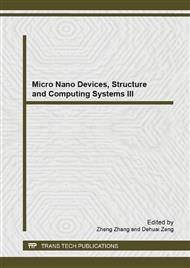p.54
p.59
p.67
p.73
p.79
p.84
p.89
p.95
p.101
Design of Self-Alignment Devices with Fluidic Self-Assembly for Flip Chip Packages in Batch Processing
Abstract:
An advanced LED multi-die-bonding integration using a fluidic self-assembly technique is proposed in the field of flip chip packages. Different form the conventional pick-and-place methods for a single LED die bonding, the fluidic approach is a relatively new design and a batch process, which can achieve not only die self-alignment but die self-assembly. Here, the size of LED die is 1-mm-square chip with the thickness of 0.3 mm. Due to the smaller size of LED die, the die-bonding process is still in need of finding a suitable approach and breakthrough. In this study, our design of fluidic self-assembly device is based on the experimental test and simulation results. The device design is the gas-flow channels with the magnetism. The width, height and length of each gas-flow channel are 1.1 mm, 0.5 mm, and 1 cm, respectively. With the restriction of the channel width, this structure design can control well to die self-alignment. In addition, the design of two circular structures in the channel can form a flat rim to achieve the die self-assemble. This mechanism of fluidic approach can be useful to the LED die self-alignment and self-assembly in the future batch processing.
Info:
Periodical:
Pages:
79-83
Citation:
Online since:
April 2014
Authors:
Keywords:
Price:
Сopyright:
© 2014 Trans Tech Publications Ltd. All Rights Reserved
Share:
Citation:


